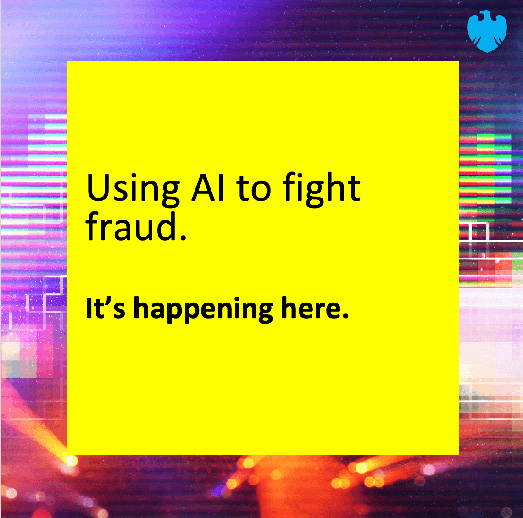
If you want to understand the scale of technology challenges at Barclays, it pays to follow the money. Barclaycard Payments processes nearly 40 per cent of all credit and debit card transactions in the UK. At peak times, our systems are managing 1212 transactions a second from Barclays and Barclaycard customers, as well as the PDQ systems that underpin cashless shopping.
We do all this in a payments landscape that’s evolving faster than ever before. “In the past, people didn’t see the way they paid for things as a lifestyle choice. But smartphones and payment apps are changing the market rapidly. With those changes come new risks around fraud,” explains David Jeffrey, Product Director, Intelligent Payments & Risk.
As we continue to introduce next-generation products and services in new sectors and regions, Barclaycard put together a cross-business team who took real personal accountability for developing and implementing the technology solutions we need to manage risk and controls at scale.
“An important part of how we run the Payments business is to do all we can to limit and prevent all types of merchant risk,” says Chris Read, Vice President for Corporate Risk Strategy, Barclaycard Payments. “It’s a part of bringing a consistently excellent approach to all of our operations.”
We call this area Merchant Risk Monitoring. It mainly comes down to spotting anomalies in transaction data. In the past, our approach relied on analysts studying the data manually after the fact, and creating new rules that would trigger the alerts in the future. Each of those alerts had to be assessed by investigators, who had to decide which ones to look into more deeply.
Barclaycard wanted to move away from manual rule-setting to the more automated development of models, supplemented by rules. By doing so, we could create more agile controls and act faster to fight crime. The project seemed a perfect candidate for a machine learning solution. “Humans can only do so much,” says David. “Whereas machine learning excels at identifying the patterns emerging from complexity and constantly improving its models.
“Anything can be broken down into data. If you break down the data far enough, you can identify norms and build models that look for things outside the norm. Then you can start to separate genuine anomalies from natural spikes in activity by rationalising it against data from the outside world.” For instance, a sudden increase in transactions on gambling sites might be unusual but not if it’s the day of the Cheltenham Gold Cup.
We worked closely with an AI machine learning company to develop a solution that was scalable for the future, and we put it to work for the Fraud team. Once that platform was proven, we started the process of bringing all four teams together on the same application.
“The programme was a massive team effort,” says David. “From technical experts to customer-facing teams, we had to work together to ensure an end-result that delivered for everyone.”
Papiya Das agrees. “From the very first day, it felt like we were one team, collaborating together to make a difference. No matter what part of the project you were on, no matter the circumstances, you could always reach out for help. It’s one of the things that makes working at Barclays so special.”
Papiya Das is now a Solution Architect in the Fraud Prevention Team. But at that time she was in charge of end-to-end testing on the multi-tenancy platform project.
The plan was for integration to take around a year. But things weren’t that simple. “There was so much sensitive data to store and such strict security requirements. We had to balance the benefit of all the teams being able to bring information together to fight fraud, with the need for individual details not to be shared across different teams and parts of the business.”
It was in the final stages that the team noticed a small data anomaly in the platform. “The data we were pulling through wasn’t in the correct format,” explains Papiya. “It could have been a small issue. But we weren’t sure if it was something more endemic, and we knew if it was, the risk to the business would be significant.”
“It was a very small error in the code,” says David. “It would have been easy to correct it and say everything will be ok. But the team collectively made the decision to delay. We checked the entire platform again and realised the data issue was larger than anticipated. If we had gone ahead, there could have been operational disruption for our merchants.”
“I’m really proud that, in the face of a huge amount of pressure, we took the difficult decision to delay the project launch. We showed the courage to speak up, challenge and do the right thing. Then we fixed the issues quickly and went live a month later with the confidence.”
The multi-tenancy platform has been running since November 2022. Its impact has been immediate. With all four teams on the same platform, and a more dynamic, configurable user experience for all, there’s more collaboration and more opportunity to spot fraudulent activity faster.
“We’ve already cut some operational processes in Credit Risk from an average of three days to well under a day,” says Chris.
The project hasn’t just been good for Barclays. It’s been a great personal journey for the people involved. “I’ve been working on pretty much the same programme since I started with Barclays,” says Papiya. “But I’ve explored a number of different roles.”
“My natural curiosity meant that when I was managing the testing of the platform, I used to delve into how the tech worked. This led to my new role as a Solution Architect. I’ve moved from end-to-end testing to end-to-end application design.”
“There are always lots of opportunities for mobility at Barclays. There’s so much support to explore what you want to do and find your personal path.”
Supporting people, protecting merchants, safeguarding Barclaycard. It’s happening here.


